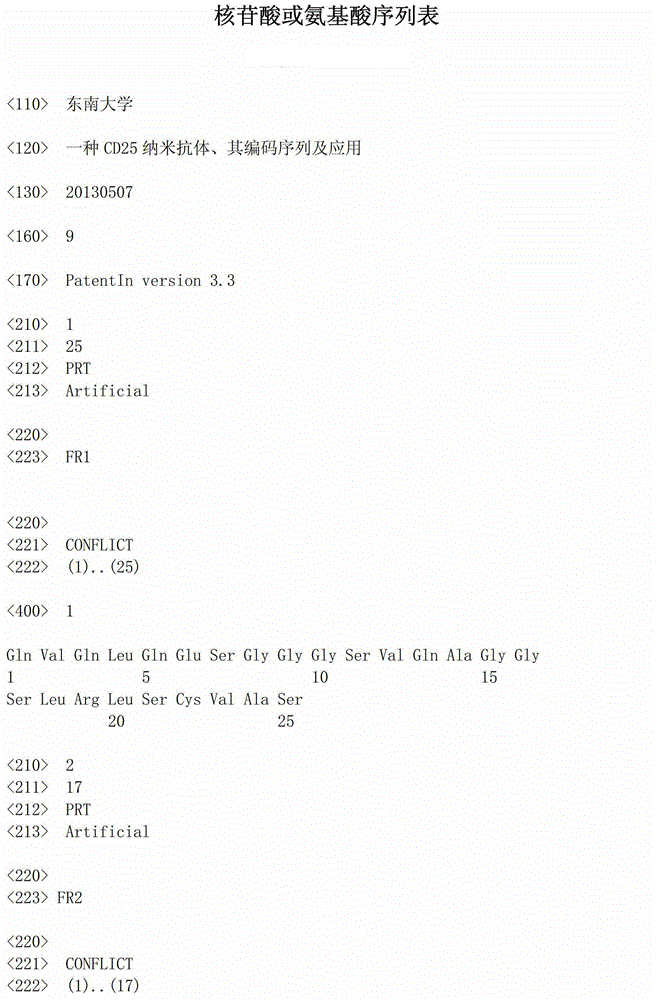CD25 nanometer antibody as well as coding sequence and application thereof
A nanobody and sequence technology, applied in the field of biomedicine or biopharmaceuticals, to achieve high-efficiency expression
- Summary
- Abstract
- Description
- Claims
- Application Information
AI Technical Summary
Problems solved by technology
Method used
Image
Examples
Embodiment 1
[0018] Example 1: Construction of Nanobody Library against CD25:
[0019] (1) Synthesize CD25 polypeptide first, mix 1mg CD25 polypeptide with Freund's adjuvant in equal volume, immunize a Xinjiang dromedary (provided by Jurong Shenglong Livestock Breeding Factory), once a week, immunize 7 times in total, and stimulate B The cells expressed antigen-specific nanobodies; (2) After the 7 times of immunization, 100 mL camel peripheral blood lymphocytes were extracted and total RNA was extracted; (3) cDNA was synthesized and VHH was amplified by nested PCR; 20 μg pComb3 phage display vector (supplied by Biovector) and 10 μg VHH were digested with endonucleases PstI and NotI, and the two fragments were ligated; (5) The ligated product was transformed into electroporation-competent cells TG1 to construct a CD25 nanobody library and measure the library capacity, Storage capacity is 1.85×10 8 .
Embodiment 2
[0020] Example 2: Nanobody screening process against CD25:
[0021] (1) Dissolve in 100mM NaHCO 3 , 20μg CD25 in pH 8.2 was coupled to NUNC microtiter plates, and placed overnight at 4°C; (2) Add 100uL 0.1% casein the next day, and block at room temperature for 2h; (3) After 2h, add 100uL phage ( 5×1011tfu immunized camel nanobody phage display gene library), and reacted at room temperature for 1 hour; (4) Washed 5 times with 0.05% PBS+Tween-20 to wash off unbound phage; (5) Use 100mM TEA (triethylamine) Dissociate the phage that specifically binds to CD25, and infect Escherichia coli TG1 in logarithmic phase growth, culture at 37°C for 1 hour, produce and purify the phage for the next round of screening, repeat the same screening process for 3-4 rounds, gradually enriched.
Embodiment 3
[0022] Example 3: Using phage enzyme-linked immunosorbent method (ELISA) to screen specific single positive clones:
[0023] (1) From the cell culture dish containing phage after the above 3-4 rounds of selection, pick 96 single colonies and inoculate them in TB medium containing 100 micrograms per milliliter of ampicillin (1 liter of TB medium contains 2.3 grams of phosphoric acid Potassium dihydrogen, 12.52 grams of dipotassium hydrogen phosphate, 12 grams of peptone, 24 grams of yeast extract, 4 milliliters of glycerol), after growing to the logarithmic phase, add IPTG with a final concentration of 1 millimolar, and cultivate overnight at 28 ° C. (2) Use the infiltration method to obtain the crudely extracted antibody, and transfer the antibody to an antigen-coated ELISA plate, and place it at room temperature for 1 hour. (3) Wash off the unbound antibody with PBST, add a mouse anti-HA tag antibody (anti-mouse anti-HA antibody, purchased from Beijing Kangwei Century Biotech...
PUM
| Property | Measurement | Unit |
|---|---|---|
| purity | aaaaa | aaaaa |
Abstract
Description
Claims
Application Information
 Login to View More
Login to View More - R&D Engineer
- R&D Manager
- IP Professional
- Industry Leading Data Capabilities
- Powerful AI technology
- Patent DNA Extraction
Browse by: Latest US Patents, China's latest patents, Technical Efficacy Thesaurus, Application Domain, Technology Topic, Popular Technical Reports.
© 2024 PatSnap. All rights reserved.Legal|Privacy policy|Modern Slavery Act Transparency Statement|Sitemap|About US| Contact US: help@patsnap.com










